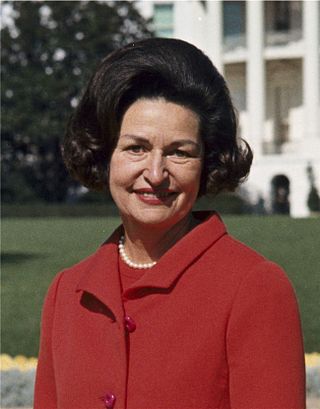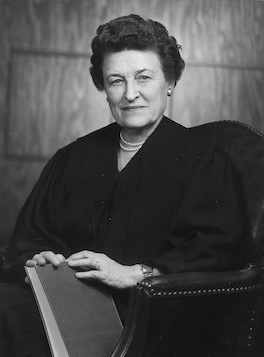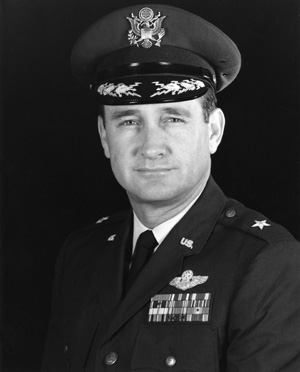
Lyndon Baines Johnson, often referred to by his initials LBJ, was an American politician who served as the 36th president of the United States from 1963 to 1969. He became president after the assassination of John F. Kennedy, under whom he had served as the 37th vice president from 1961 to 1963. A Democrat from Texas, Johnson also served as a U.S. representative and U.S. senator.

Air Force One is the official air traffic control designated call sign for a United States Air Force aircraft carrying the president of the United States. In common parlance, the term is used to denote U.S. Air Force aircraft modified and used to transport the president and a metonym for the primary presidential aircraft, VC-25, although it can be used to refer to any Air Force aircraft the president travels on.

Claudia Alta "Lady Bird" Johnson was the First Lady of the United States from 1963 to 1969 as the wife of President Lyndon B. Johnson. She served as the second lady from 1961 to 1963 when her husband was vice president.

Sarah Tilghman Hughes was an American lawyer and federal judge who served on the United States District Court for the Northern District of Texas. She is best known as the judge who swore in Lyndon B. Johnson as President of the United States on Air Force One after John F. Kennedy was assassinated in Dallas on November 22, 1963. She is the first and only woman to have sworn in a US President. The photo depicting Hughes administering the oath of office to Johnson is widely viewed as the most famous photo ever taken aboard Air Force One.

The National Museum of the United States Air Force is the official museum of the United States Air Force located at Wright-Patterson Air Force Base, six miles (9.7 km) northeast of Dayton, Ohio. The NMUSAF is the oldest and largest military aviation museum in the world, with more than 360 aircraft and missiles on display. The museum draws about a million visitors each year, making it one of the most frequently visited tourist attractions in Ohio.

The Boeing VC-25 is a military version of the Boeing 747 airliner, modified for presidential transport and commonly operated by the United States Air Force (USAF) as Air Force One, the call sign of any U.S. Air Force aircraft carrying the president of the United States.

The Ronald Reagan Presidential Library is the repository of presidential records from the Reagan administration. Located in Simi Valley, California, the library is administered by the National Archives and Records Administration and is the burial place of Ronald and Nancy Reagan. It contains millions of documents, photographs, films and tapes. It also contains memorabilia and a permanent exhibit of Ronald Reagan's life.

Air Force Two is the air traffic control designated call sign held by any United States Air Force aircraft carrying the vice president of the United States, but not the president. The term is often associated with the Boeing C-32, a modified 757 which is most commonly used as the vice president's transport. Other 89th Airlift Wing aircraft, such as the Boeing C-40 Clipper, C-20B, C-37A, and C-37B, have also served in this role. The VC-25A, the aircraft most often used by the president as Air Force One, has also been used by the vice president as Air Force Two.

SAM 27000 was the second of two Boeing VC-137C United States Air Force aircraft that were specifically configured and maintained for the use of the president of the United States. It used the call sign Air Force One when the president was on board, and at other times it used the call sign SAM 27000, with SAM indicating 'Special Air Mission.' The VC-137C serial number 72-7000 was a customized version of the Boeing 707 which entered service during the Nixon administration in 1972. It served all US presidents until George W. Bush and was retired in 2001. It is now on display at the Ronald Reagan Presidential Library.

Cecil William Stoughton was an American photographer. He is best known for being President John F. Kennedy's photographer during his White House years.

On April 22, 1994, Richard Milhous Nixon, the 37th president of the United States, died after suffering a significant stroke four days earlier, at the age of 81.
LBJ: The Early Years is a television movie that appeared on the NBC network in February 1987, depicting the pre-presidential life of Lyndon B. Johnson, the 36th president of the United States. Actor Randy Quaid won a Golden Globe award for his portrayal of Johnson.

The first inauguration of Lyndon B. Johnson as the 36th president of the United States was held on Friday, November 22, 1963, aboard Air Force One at Dallas Love Field, following the assassination of President John F. Kennedy earlier that day. The inauguration – the eighth non-scheduled, extraordinary inauguration to ever take place – marked the commencement of the first term of Lyndon B. Johnson as president.

The United States Air Force Special Air Mission provides air transportation for the president of the United States (POTUS), vice president of the United States (VPOTUS), first lady of the United States (FLOTUS), presidential Cabinet, U.S. congressional delegations (CODELs), and other high-ranking American and foreign dignitaries.

In the United States, state funerals are the official funerary rites conducted by the federal government in the nation's capital, Washington, D.C., that are offered to a sitting or former president, a president-elect, high government officials and other civilians who have rendered distinguished service to the nation. Administered by the Military District of Washington (MDW), a command unit of the Joint Force Headquarters National Capital Region, state funerals are greatly influenced by protocol, steeped in tradition, and rich in history. However, the overall planning as well as the decision to hold a state funeral, is largely determined by a president and their family.

The Boeing C-137 Stratoliner is a retired VIP transport aircraft derived from the Boeing 707 jet airliner used by the United States Air Force. Other nations also bought both new and used 707s for military service, primarily as VIP or tanker transports. In addition, the 707 served as the basis for several specialized versions, such as the E-3 Sentry AWACS aircraft. The designation C-18 covers several later variants based on the 707-320B/C series. The C-137 should not be confused with the similar Boeing C-135 Stratolifter; although they share a common ancestor the two aircraft have different fuselages, among other structural differences.

James Underwood Cross was a United States Air Force brigadier general and author of Around the World with LBJ: My Wild Ride As Air Force One Pilot, White House Aide, and Personal Confidant, with Denise Gamino and Gary Rice. He was a military aide and chief Air Force One pilot under United States president Lyndon B. Johnson.

The United States foreign policy during the 1963-1969 presidency of Lyndon B. Johnson was dominated by the Vietnam War and the Cold War, a period of sustained geopolitical tension between the United States and the Soviet Union. Johnson took over after the Assassination of John F. Kennedy, while promising to keep Kennedy's policies and his team.



















